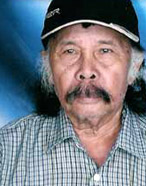 |
||
|---|---|---|
| CP Foundation | About CP Biennale | 2003 | 2005 | Contact Us | >||
           
|
||
|
Amrus's works, made of stylized wood with a rough surface, reminded us of primitive sculptures. Amrus often said that when he worked, he associated himself neither with the past nor with the works of the other artists around him. His belief in originality pushed him to create works with strong characters. Naturally, the strength of Amrus's works were not only in the characters of the wood chiseled in such a way so that the primitive images and patterns were manifested; but also in the unity of the themes, the images, the media, and the methods. In terms of themes, Amrus generally told of the bitter plights of the marginalized, as could be seen in his wooden sculptures People Whose Rights Are Taken Away at Dusk, (1955) or The Forgotten Blind Man, (1955). In 1963, he went to the forests in Lampung, Sumatra, and stayed there for months on end, working on several sculptures. Even during his imprisonment in Tangerang from 1968 to 1973, on the charge of being a member of Lekra (an artists' group closely associated with the Indonesian Communist Party), Amrus still kept himself busy by working on some wooden sculptures. In 1979, Amrus opened a workshop in Ancol Art Market, and, still loyal to wood, Amrus continued to analyze, explore, and try out various artistic possibilities that he might gain from the material. His efforts were not futile. He finally found a new visual idiom: wooden "painting." Amrus did not paint on wood, but rather made "painting"--or a kind of wooden mural--out of wood. This was indeed a new idiom in the contemporary art practice in Indonesia. From this point of view, the fine art tradition would categorize Amrus's wooden "painting" as a craft; and thus practically marginalizes it. This showed exactly the weakness of the modern fine art traditions. Amrus, who did not care about the limitations and norms posed by the modern fine art traditions, believed that "painting" did not always involve brushes and canvases--it could very well use chisels and axes on wood. The result could be seen in the splinters and bits of wood that betrayed the sharpness of the tools, and the wooden bits and pieces depicted stories with various themes. By using this technique, Amrus had actually married off wooden sculptures and paintings. In this biennale, Amrus presented his wooden work titled Konstruktivisme (Constructivism). The idea for this particular work came out of his observation and experience in analyzing life and the reality of various objects on earth. According to him, everything in nature consisted of sundry constructions that gave rise to abundant forms--whether moving or static. Nature constructions can be seen, for example, in beehives, anthills, bird nests, coal, and diamonds. Amrus believed that this "constructivism" is the base on which everything is built--whether in nature or in the minds of humans. Chandra Johan Born on October 21, 1933 in Medan. SELECTED SOLO EXHIBITIONS SELECTED GROUP EXHIBITIONS |
||
|
CP Foundation | About CP Biennale | 2003 | 2005 | Contact Us
Jl. Suryopranoto 67A, Jakarta 10160, Indonesia. ph. +62.21.3448126, 3853206 | fax. +62.21.3853203, 3853208 info@cp-foundation.org |
||
 Amrus Natalsya is one of the few Indonesian sculptors who are forever exploring new idioms in their creations. In the beginning of his artistic career, Amrus was sculpting and painting in turns, as was common among the artists in Yogyakarta at the time. But then Amrus turned increasingly to sculpting as the medium for his art. If we take into account the development of modern art in Indonesia during the 1950s, Amrus's works seemed to appear as a deviation from the general tendency. Naturally, Amrus has never moved away from the sphere of the realism. Realism in Amrus's works, however, did not portray merely the realistic images as they were commonly found in figurative sculptures, made by molding using clay models.
Amrus Natalsya is one of the few Indonesian sculptors who are forever exploring new idioms in their creations. In the beginning of his artistic career, Amrus was sculpting and painting in turns, as was common among the artists in Yogyakarta at the time. But then Amrus turned increasingly to sculpting as the medium for his art. If we take into account the development of modern art in Indonesia during the 1950s, Amrus's works seemed to appear as a deviation from the general tendency. Naturally, Amrus has never moved away from the sphere of the realism. Realism in Amrus's works, however, did not portray merely the realistic images as they were commonly found in figurative sculptures, made by molding using clay models.